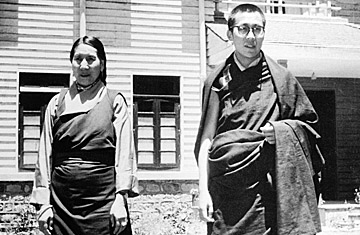
May 28, 1959: Tenzin Gyatso, the 14th Dalai Lama, and his mother, shortly after the Tibetan Buddhist ruler fled his homeland for exile in northern India
(3 of 9)
The Search. The present Dalai Lama's predecessor was one of the greatest of his line. He lived long and governed well. In 1933, warned by the State Oracle that his end was approaching, he summoned a photographer all the way from Nepal to take a final picture, and shortly thereafter this most sacred Living Buddha shed the garment of his body in order to assume another. While by Lamaist teaching his soul went to dwell for 49 days in the famed Lake Chö Kor Gye before taking up residence in a newborn infant, his corpse was embalmed by being cooked in yak butter and salt, its face painted with gold, and the mummy seated upright facing south in a shrine of the Potala.
Who was the newborn infant in whom his soul was reincarnated? A four-year search began, and became another of the endless legends of Tibet. The regent, who ruled the state during the interregnum, journeyed to Lake Chö Kor Gye and, after gazing into its mirrored waters, reported a vision of a three-storied lamasery whose golden roof was necked with turquoise, and a winding road that led to a gabled farmhouse of a type unknown to Lhasans. Search parties went out in all directions without success. Finally the oracle of Samye monastery, Tibet's oldest, went into a trance, recommended that the search be extended to the Chinese province of Tsinghai, whose Amdo region is largely populated by Tibetans.
In Tsinghai. the priestly caravan was met by the ninth Panchen Lama, who had fled to China after difficulties with the 13th Dalai Lama. Near death himself, the Panchen Lama was not bitter, and suggested the names of three young boys who might be possible candidates. The first child had already died when the lamas reached him; the second ran screaming at the sight of them. At the home of the third child, on the shores of fabled Lake Koko Nor, the monks were struck dumb. Just as in the regent's vision, there was a peasant house with a gabled roof, there was a winding road and, beyond, a three-storied lamasery whose golden dome sparkled with turquoise tiles.
As the awed monks approached the farmhouse, a small boy rushed toward them from the kitchen crying, "Lama! Lama!" His name was Lhamo Dhondup; he was two years old; and one of his brothers was already a Living Buddha at Kumbum monastery. Interrogated, the child gave the correct title of every official in the party, even picking out those who were disguised as servants. The second test required that he examine duplicate rosaries, liturgical drums, bells, bronze thunderbolts, and teacups, and select the ones that had belonged to him in his previous life as the 13th Dalai Lama. He did it with ease. Overjoyed, the lamas also found that the child had the required physical marks: large ears, and moles on his body that represented a second pair of arms. Then, in the final test, he was offered a choice of identical walking sticks. To the monks' horror, little Lhamo chose the wrong one—but at once threw it away. Seizing the right stick, he refused to be parted from it.
